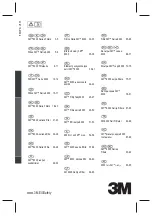
THERMOJET
®
G3500E SERIES
OIL PURIFIER SYSTEM
INSTALLATION AND OPERATING MANUAL
Doc #
77740123
Rev
14
Date
June 2020
Page
15
of
104
Principal of Operation
The ThermoJet Oil Purifier works on the principal of air stripping. The use of air or nitrogen bubbled
through contaminated liquids has long been used to remove contaminants. But the use of this
technique was restricted because the volume of gas required was large due to limited mixing of the gas
with the liquid. The unique technology embodied by the ThermoJet
makes air/gas stripping practical and
efficient because of the mixing and intimate contact of the air/gas with the fluid being cleaned. In
addition, the ThermoJet
utilizes the principal that the capacity of a gas to entrain moisture increases
exponentially with temperature.
The ThermoJet is designed to operate on ISO 32 through ISO 220 oils from circulating oil systems. Oil with
higher viscosity (ISO 150 and ISO 220) must be at 40
o
C (100
o
F) minimum temperature at the inlet to the
ThermoJet during start-up.
Degasification
The ThermoJet
®
removes dissolved light hydrocarbon gases such as propane and H
2
S from industrial
lubricants. In refineries and petrochemical plants an ideal application for the ThermoJet
is the removal of
hydrogen sulfide from compressor seal oil. The ThermoJet
returns the viscosity of the lube oil and
restores the oil flash point to like new levels. No longer is there a need to dispose of gas laden and sour
lube oils; these oils can be purified and reused.
Flow through the Unit
The suction pump of the ThermoJet
draws contaminated oil from the user lube, seal or hydraulic
system. Flexible hose or hard piping can be used to connect the ThermoJet
to the system reservoir. A
one and one half horsepower motor drives the suction pump. The suction pump is protected by a “Y”
strainer. From the pump the oil passes through a filter. This cartridge filter can be easily replaced. It
is recommended replacement be made when the pressure differential across it, as monitored by two
easily read gages which are externally mounted on the panel above the access door, reaches 2 BAR
( 30 PSI). From the filter the oil passes through the heater that elevates the oil to 82° C (180° F).
The electric heater temperature is set and controlled with a solid-state device whose operation is
viewed through a window on the electrical control box. After the heater, the oil passes through the
heart of the ThermoJet
which is the dual stage jet mixer
The Jet Mixer
This proprietary and uniquely designed device is the heart of the system. Without the aid of secondary
pressure, it continuously and automatically draws ambient air or inert gas such as nitrogen into the heated
oil stream as delivered to it by the inlet pump. The ambient air/gas becomes intimately mixed with the oil
and assumes the temperature of the oil. The oil leaves the Jet Mixer and is directed to the separation
vessel that operates at atmospheric pressure. Here the moisture laden air, or gas saturated nitrogen,
expands and leaves the oil thus cleansing the oil of water or dissolved hydrocarbon gases.
Return of Clean Oil
In the separation vessel the oil from the jet mixer cascades down trays to promote the release of the
saturated air/gas. A volume of oil is maintained in the lower portion of the separation vessel to allow
any entrained air to leave the oil so that none is contained in the return oil stream. The second close
coupled pump driven by the electric motor returns oil to the user reservoir. Water vapor vents from the
separation vessel and travels through a filter and oil absorbing media to insure that discharge from the
unit is oil free. The water condensate discharged from the ThermoJet
can be piped to a sanitary sewer.
Mounting Options
The ThermoJet Model G3700
Oil Purifier is offered in two different mounting configurations so that the unit
can best fit client requirements. All series units are available as base mounted with lifting eyes.
















































